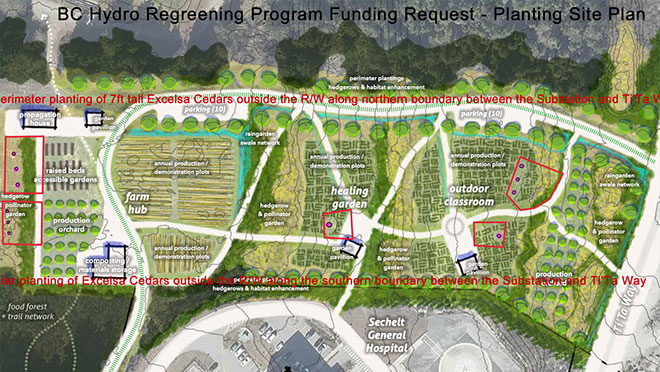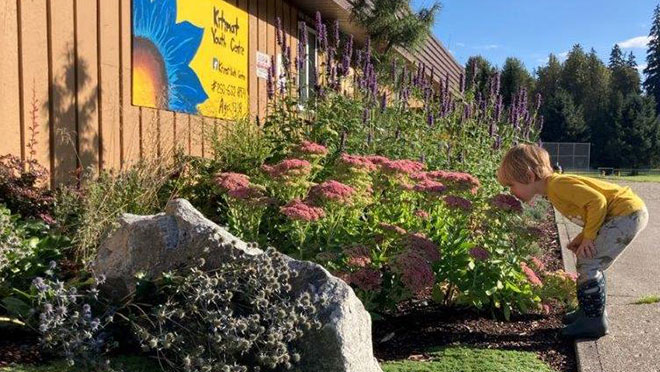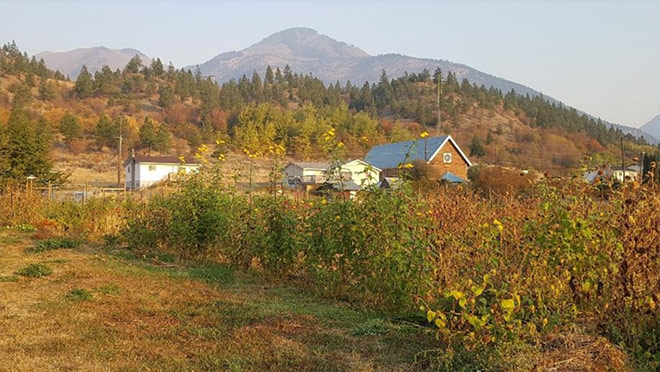
This article was published by BC Hydro on May 1, 2023.
BC Hydro’s Community ReGreening program isn’t only about replacing trees near power lines. It’s about reinforcing the idea of “right tree, right place”, and about working with communities to add pollinator habitat, plants of cultural importance to First Nations, and even farms for food.
This year’s crop of pre-approved regreening funding across B.C. is 63 projects long, and it features funding for a pollinator garden on Grand Boulevard in North Vancouver, and for trees on the perimeter of an ambitious shíshálh Nation regenerative farm project in Sechelt. Last year’s projects included funding for a windbreak to protect an orchard on an Indigenous-run community farm near Lillooet.
“Yes, we’re the folks who come by and remove branches and trees that are going to be an impact on our system,” says Jeff Labelle, a vegetation manager with BC Hydro’s distribution group. “So it sure is nice to be able to give back, to provide funding so communities can bring people together to beautify the place they live. It’s part of helping turn our cities and our urban environments back into something more natural.”
Bees, butterflies, hummingbirds and other pollinators would love that to happen in a big way. Habitat loss, disease, parasites, and environmental contaminants have all contributed to the decline of many species of pollinators. BC Hydro is among a growing number of organizations in Canada offering funding and resources to add pollinator habitat, which is rising up in parks, backyards, and under power line rights of way.
Funding for pollinator habitat, and for initiatives to grow plants of cultural significance to First Nations, is now a part of a community regreening program that had previously focussed on planting trees. Qualifying projects range from the restoration of urban canopies, to beautification of parks and recreation areas, to the creation of natural habitats.

Several projects target areas under BC Hydro power lines
On B.C.’s Sunshine Coast, the shíshálh Nation is working with the Salish Seas Regenerative Farm Society to regenerate six-plus acres of barren land behind Sechelt Hospital below power lines near a BC Hydro substation. The demonstration farm will replace scrubby, invasive species with a mix of pollinator habitat, bee hives, and vegetable gardens that will help rejuvenate the soil while also producing food for a community that relies almost entirely on produce from the mainland.
One of B.C.’s signature pollinator gardens is the colourful corridor under our power lines in Richmond, a project that got off the ground in 2015 via a collaboration between BC Hydro, Emily Carr University of Art + Design, the City of Richmond and several community and corporate sponsors. The Bridgeport Public Art Pollination Pasture started with a cover crop of alyssum, red clover, phacelia, and mustard that improved soil conditions, beautified the site, and created a lush pollinator habitat. Carved log seating and wild apiaries (insect hotels), were included at the site.
Meanwhile, flowers are cropping up under our transmission power lines strung along Anderson Lake northeast of Pemberton.
“We seeded areas with flowers mixed in with grasses and other plants,” says BC Hydro pest and vegetation biologist Rene Roddick. “It helps hold the soil and provides pollinator habitat.”

Kids learning plenty from pollinator gardens
As pollinator gardens take root across the province, including in urban areas, students are getting their hands dirty as they’re introduced to nature in a fun way.
“The kids love being part of any planting, and they love just observing the critters,” says Jana Ronne, a teacher at Gladstone Secondary school in East Vancouver. “When we’re in the growing season, we have one day a week at lunch hour where a parent comes and opens up a box of tools. We leave it unstructured. Maybe students do some weeding, but they usually end up just digging for worms. We never have trouble attracting the kids into the garden. And they love shovels.”
In a recent Power Smart For Schools blog post about pollinator gardens, Ronne said gardens can help kids overcome their fears about bees and other insects.
“Some kids are so unfamiliar with insects that anything that flies around their head scares them,” she says. “When we go out to the garden and something starts flying, they run. It’s that extreme of a response.”
Children and adults alike are learning that most bees have no interest in stinging you, that some don’t even have stingers, and that pollinators include butterflies, wasps, and ants. According to BC Hydro biologist Roddick, blue-purple flowers seem to be most popular with bees, who benefit greatly from a mix of early- and late-blooming flowers.
“We have a lot of flowers coming up right now in the next week or so,” said Roddick, speaking in mid-April. “This place is going to be going nuts with bees and flowers, and the bees have so much to choose from at this time of year. They’re just thrilled and there are no worries. But by the end of summer, your tulips and many other flowers are kind of gone. So late-flowering species are really great to include in a garden.”
Why do pollinators matter? About a third of our diet as humans comes directly or indirectly from insect-pollinated plants.
“I talked to a farmer who had put mason bees in his orchard,” recalls Roddick. “The year he introduced the bees, he said the trees in his orchard were so heavy with apples that branches were breaking from the weight. Everything was just loaded up.”

Near Lillooet, a fruit orchard in a community farm gets some protection
Strong winds off Seton Lake were damaging a fruit tree orchard that’s part of the T’it’q’et Community Landscape Project aimed at regreening the community.
The T’it’q’et, a St’at’imc community near Lillooet, applied for BC Hydro funding last year to plant perennials and trees that will act as a windbreak designed to protect the orchard in what’s known as the Ucwalmicw Community Farm, an Indigenous-led food security project. The farm provides opportunities for new community farmers without land: community incubator farmers can work up to 25 paid hours a week on a plot, then sell their produce at the local farmers market in May and June.
Where there was once an empty field alongside the orchard, the BC Hydro funding has helped add 40 different varieties of shrubs, medicine plants, flowers and perennial food crops such as rhubarb and walking onions. A group of 20 high school students has helped out, learning about the importance of biodiversity.


Be the first to comment